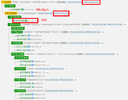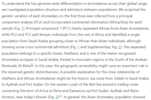And could that mean ancestral Somali homeland would be the north?
Dialects from, Djibouti, Somaliland, Khatumo, Western Somalia, would all be considered northern dialects. I would add mudug dialect too, but that's just my opinion. There's a lot of diversity in these dialects, and many times even among the same qabiil. For example Burco dialect is not quite the same as Berbera dialect or lasanaod dialect.
Djibouti dialect is not quite the same as Sitti dialect.
Imey and Babile dialects are different from Jjigjiga dialect.
Jigjiga dialect is different from Hargaysa dialect. You get my point. Here's the interesting part, all these people speak ONLY somali, no other language. You might say what the f*ck are you talking about? well keep reading.
When we look at southern Somalia, we don't observe the same thing. The Somali dialects spoken in the south is a lot less, maybe 2 max. Mogadisho has a unique dialect, everyone else speaks the same. But here's the interesting part, there are a lot of completely different languages spoken there. For example, af may, af tuni, af ajuuraan and a bunch more that your average af maxaa tiri speaker wouldn't understand. I am not even including banaadiri or bantu languages as these two aren't even ethnically Somali. I am talking about ethnic Somalis speaking in a completely different language. How do we explain this? Why is the south more influenced by these people than the north?
Would this point to the north as being the ancestral homeland for geeljires? If not and the south is our ancestral homeland, wassup with these people speaking all these languages, where the hell are they from?
@Aurelian
@Himmler
@MarcusAbdul
@Reformed J
@The alchemist
Dialects from, Djibouti, Somaliland, Khatumo, Western Somalia, would all be considered northern dialects. I would add mudug dialect too, but that's just my opinion. There's a lot of diversity in these dialects, and many times even among the same qabiil. For example Burco dialect is not quite the same as Berbera dialect or lasanaod dialect.
Djibouti dialect is not quite the same as Sitti dialect.
Imey and Babile dialects are different from Jjigjiga dialect.
Jigjiga dialect is different from Hargaysa dialect. You get my point. Here's the interesting part, all these people speak ONLY somali, no other language. You might say what the f*ck are you talking about? well keep reading.
When we look at southern Somalia, we don't observe the same thing. The Somali dialects spoken in the south is a lot less, maybe 2 max. Mogadisho has a unique dialect, everyone else speaks the same. But here's the interesting part, there are a lot of completely different languages spoken there. For example, af may, af tuni, af ajuuraan and a bunch more that your average af maxaa tiri speaker wouldn't understand. I am not even including banaadiri or bantu languages as these two aren't even ethnically Somali. I am talking about ethnic Somalis speaking in a completely different language. How do we explain this? Why is the south more influenced by these people than the north?
Would this point to the north as being the ancestral homeland for geeljires? If not and the south is our ancestral homeland, wassup with these people speaking all these languages, where the hell are they from?
@Aurelian
@Himmler
@MarcusAbdul
@Reformed J
@The alchemist


